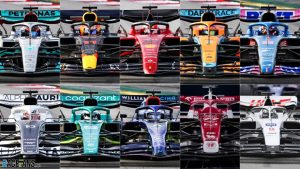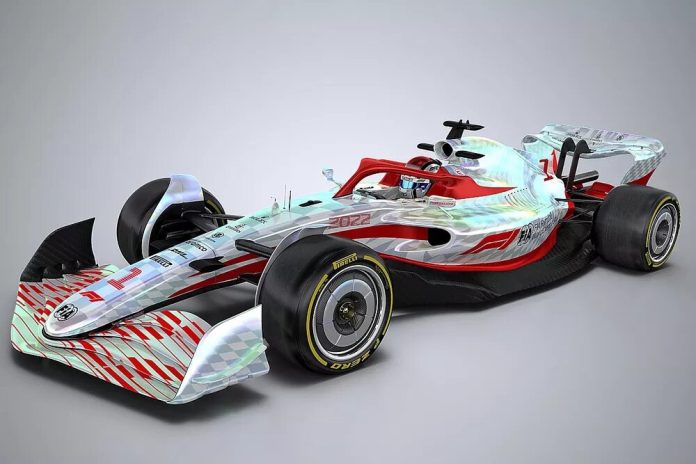Introduction to the 72nd Season of Formula 1
A brand new Formula 1 season is upon us, new tracks, new drivers but most importantly, new regulations for 2022 pave the way for a new generation of Formula 1 car. Formula 1 has been developing the 2022 spec car for many years with one main goal, allow for the cars to be able to follow one another more closely. New regulations allow for the cars to take the most advantage of ground effect. Ground effect has been banned in Formula 1 since the 90’s, but recent concern over the lack of close racing compared to older generations of F1 sparked research into “dirty air” and it’s effects on Formula 1 cars. 2021 spec Formula 1 cars relied heavily on downforce produced by exterior wings and large bargeboards, but these exterior parts create a larger wake, meaning more “dirty air” for following cars to race through. Formula 1 has decided to move away from overly crowded wings and side skirts, and have optimized a more minimalist design for the front wing and sidepods. But always along with new regulations, teams have found ways to bring in their own special mechanical genius, and designs, giving us fans 10 starkly different cars to marvel upon. Formula 1 has implemented a budget cap for each team to follow of $140 million US dollars, the FIA is attempting to make teams race closer together regardless of the difference in sponsorship money fielded. In 2020 the highest spending team was Mercedes who spent roughly $450 million USD whereas teams such as Racing point and Williams both spent under $200 million. The new budget restrictions does not include driver salaries but does include all research and development of the team’s chassis. This budget will drop $5 million dollars next year as the FIA tries to encourage more teams to join the F1 field.

New Faces Around the Paddock
Formula 1 only has 20 seats within the sport, making it one of the most competitive markets always looking for new talent. Alfa Romeo Racing Orlen completely refreshed their lineup after the retirement of F1 legend, Kimi Raikkonen, and the replacement of Antonio Giovinazzi, the Swiss team bring in a 5 time Constructors Champion and 10 time race winner, Valtteri Bottas. The Finnish driver was formerly a member of Mercedes AMG Petronas, where he was 2 time Drivers Championship runner up to longtime teammate to Lewis Hamilton. The second man brought in by Alfa Romeo was Chinese rookie driver Zhou Guanyu. Zhou finished 3rd in the 2021 Formula 2 season and is the First Chinese born F1 driver. Haas F1 originally intended on keeping their duo of sophomore drivers, Mick Schumacher and Nikita Mazepin, but after Russia’s invasion of Ukraine, Nikita who is son of Russian oligarch Dmitry Mazepin, was cut from the Haas lineup and Dmitry’s company Uralkali, a title sponsor of Haas, had their contract suspended. Brought in to replace Nikita, former Haas F1 driver Kevin Magnussen, who had raced with the team just 2 years before, but was replaced by the younger Schumacher, and Mazepin, who both also brought in more sponsorship money than Magnussen. Magnussen had dabbled in both DTM and LMP racing in his 1 year away from F1 but has quickly made his return to Guenther Steiner’s team. Mercedes AMG Petronas had to replace the outgoing Valtteri Bottas, and decided to go with long time junior and development driver George Russell. Russell had been a member of the Williams F1 team since the start of the 2019 season, and was a standout in Junior Formulas, finishing 1st in 2017 in the then GP3, now Formula 3, and finishing first the next year in Formula 2. Russell joined the Mercedes young drivers program in 2017 but never saw a chance for a seat at Mercedes so he joined a Mercedes powered team in Williams. Now Russell sees himself at Mercedes after an impressive Sakhir Grand Prix in which Russell filled in for the Covid-19 positive Lewis Hamilton. Rounding out the driver carousel, Williams chose former F1 driver Alex Albon to replace the outgoing George Russell. Tabbed as a major talent, Albon was a member of the Red Bull young drivers program and flew up the Junior Formula ranks under the Red Bull funding and found himself in F1 in 2019 joining Red Bull’s sister side named Toro Rosso at the time, now named Alpha Tauri. Albon was partnering Daniil Kyvat as recent breakout star Pierre Gasly was promoted from Toro Rosso to Red Bull. After 12 races Albon replaced Gasly midseason at Red Bull as Gasly was demoted, but after finishing the season and staying with the team one more year, Albon would be replaced by Sergio Perez. Albon was a test and reserve driver for Red Bull in 2021 but makes his return out of the shadow of the Red Bull machine with Williams. While Red Bull have yet to make a driver change this year in either of their teams, Max Verstappen will dawn a new number on the front of his matte navy machine, switching from the iconic #33 to the #1 as allowed by the FIA for the reigning World Champion to carry the #1. Nico Hulkenberg is taking over in Bahrain for the COVID positive Sebastian Vettel, a member of the Aston Martin Cognizant F1 team. Hulkenberg has been a long time F1 driver with Renault, Racing Point, and is the reserve driver for the Aston Martin team.






